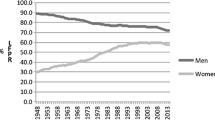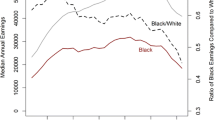Abstract
The labor force participation rate of black women has not increased as fast as that of white women in spite of the fact that black females have the characteristics economists have found most encourage participation. Also black women at all socioeconomic levels have more positive attitudes towards labor market activity. The explanation for the failure for their work rates to grow as fast as those of white women appears to be inadequate employment opportunities for black women from lower socioeconomic groups. Education in or of itself, however, is not the solution to the problem because education yields lower returns to black women with limited schooling than is true for comparable whites. Any strategy devised to solve these employment inequities must address the low relative demand for these workers.
Similar content being viewed by others
Notes
The results reported here represent a synthesis of the findings from William G. Bowen and T. Aldrich Finegan,The Economics of Labor Force Participation (Princeton, NJ: Princeton University Press, 1969); Jacob Mincer, “Labor Force Participation of Married Women,” inAspects of Labor Economics (Princeton, NJ: Princeton University Press, 1962), pp. 63–97; Thomas A, Mohaney, “Factors Determining the Labor Force Participation of Married Women,”Industrial and Labor Relations Review, XIV, no. 44 (July 1961), pp. 563–577; Glen G. Cain,Married Women in the Labor Force (Chicago: University of Chicago Press, 1966); Duran Bell, “Why Participation Rates of Black and White Wives Differ,”The Journal of Human Resources, IX (1974); Phyllis A. Wallace,Black Women in the Labor Force (Cambridge, MA: MIT Press, 1980); and Barbara A. Jones, “Factors Which Determine the Labor Force Participation Rates of Black Wives,”Proceedings of the 29th Annual Meeting of the Industrial Relations Research Association (1975).
Valerie Kincade Oppenheimer,The Female Labor Force in the U.S. (Berkeley: University of California Institute of International Studies, 1970).
Phyllis A. Wallace,Black Womenn in the Labor Force, p. 45.
Lonnie K. Stevans. Charles Register, and Paul Grimes, “Race and the Discouraged Female Worker: A Question of Labor Force Attachment.”The Review of Black Political Economy 14, no. l(Summer 1985).
Frank L. Mott, “Racial Differences in Female Labor Force Participation,”Urban and Social Science Review, Xl(1978), pp. 23–24.
Jerry W. Dauterive and James Jonish, “Wage Differences Among Black and White Career Women.”Review of Social Economy (April 1977), pp. 79–94.
Julianne Malveaux. “The Economic Interests of Black and White Women: Are They Similar?”Review of Black Political Economy, 14, no. 1 (Summer 1985), p. 16.
For example, see Frank L. Mott, “Racial Differences in Female Labor-Force Participation,” pp. 21–27.
Barbara A. P. Jones, “Labor Market Consequences of Poverty and Welfare Dependency” inUnderstanding Black Poverty and Welfare Dependency (New York: Praeger Publishers, forthcoming).
For a very persuasive argument of the economic interdependence of black males and black females see Julianne Malveaux, “The Economic Interests of Black and White Women: Are They Similar?” pp. 5–27.
Phyllis Wallace.Black Women in the Labor Force, p. 83.
About this article
Cite this article
Jones, B.A.P. Black women and labor force participation: An analysis of sluggish growth rates. The Review of Black Political Economy 14, 11–31 (1985). https://doi.org/10.1007/BF02689871
Issue Date:
DOI: https://doi.org/10.1007/BF02689871




